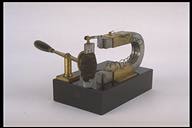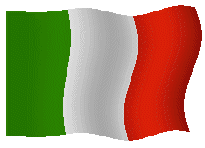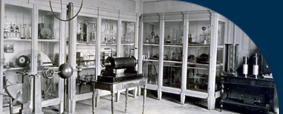
 |
Magnetic sparkler |
 |
Calamita scintillante |
| Subject: electromagnetism/manual electric spark generator |
Settore: elettromagnetismo/generatore manuale di scintille elettriche |
| Number of catalogue: 271 |
Numero di inventario: 271 |
| Unsigned, probably made by Corrado Wolf |
Non firmato, prob. Corrado Wolf |
| Florence 1847; [historical inventory, 1860] |
Periodo di costruzione: Firenze 1847 [inventario storico,1860] |
| Wood, brass, iron, copper |
Materiali utilizzati: Legno, ottone, ferro, rame |
295 X 145 X 170 [mm] |
Dimensioni: 295 X 145 X 170 [mm] |
| |
|
This instrument, which was projected and first built by physicists Leopoldo Nobili (1784-1835) and Vincenzo Antinori (1792-1865), is to be historically included among the first magneto-electric machines that were created when the discovery of electromagnetic induction, made by Faraday in November 1831, became public. This machine was then followed by Pixii's, Newman's, Saxton's, and Clarke's models. For their creation, Nobili and Antinori were inspired by a short article published on December 28, 1831 in the French newspaper "Le Temps" in which Faraday's discovery was announced and in which, simultaneously, it was reported that Faraday had achieved a "magnetic" spark by means of a rudimentary ring transformer. The "electric magnet", whose building principle was substantially different from the one suggested by Faraday, was projected and created in January 1832 most likely at the "Imperial Royal Museum of Physics and Natural History" of Florence, as may be deduced from the reading of a memoir by Nobili and Antinori distributed from the Museum on January 31, 1832. The novelty of the device consisted of the production of electric sparks with procedures that differed from the traditional mechanisms based on electrostatic machines and on voltaic piles. With this device the physicist Giuseppe Domenico Botto (1791-1865) of Turin was able to obtain the electrolysis of water. The instrument was then improved with a more powerful machine, which was called the "connected magnet machine" (magnetic sparkler), and which consisted of two horseshoe-shaped magnets and in which the rotor was moved, by means of a crank, between the poles of the magnets. |
Questo apparecchio, ideato e costruito per la prima volta dai fisici Leopoldo Nobili (1784-1835) e Vincenzo Antinori (1792-1865), è da annoverare, storicamente, tra le primissime macchine magneto-elettriche realizzate subito dopo l'annuncio della scoperta dell'induzione elettromagnetica fatta dal Faraday nel novembre del 1831. Essa precedette i modelli di Pixii, Newman, Saxton e Clarke. Nella loro realizzazione Nobili e Antinori furono stimolati da un breve articolo apparso il 28 dicembre 1831 sul giornale francese "Le Temps" in cui si annunciava la scoperta del Faraday e contemporaneamente si esaltava l'ottenimento, da parte di questi, di una scintilla "magnetica" tramite un rudimentale trasformatore ad anello. La "calamita elettrica", la cui concezione costruttiva era sostanzialmente diversa da quella proposta dal Faraday, fu ideata e realizzata nel gennaio del 1832 con ogni probabilità presso l'Imperial Regio Museo di Fisica e Storia Naturale di Firenze, come si evince dalla lettura di una memoria di Nobili e Antinori spedita da quel Museo il 31 gennaio 1832. La novità del dispositivo consisteva nella produzione di scintille elettriche con modalità diverse rispetto a quelle allora note, fornite dalle comuni macchine elettrostatiche o dalle pile voltaiche. Con questo apparato il fisico torinese Giuseppe Domenico Botto (1791-1865) riuscì ad ottenere l'elettrolisi dell'acqua. Esso fu in seguito perfezionato con un modello più potente, detto a "calamite conjugate", costituito da due magneti a ferro di cavallo in cui l'indotto si muoveva, mediante una manovella, nello spazio compreso tra i poli dei due magneti. |
| |
|
Description: A horseshoe-shaped nickel-plated iron magnet is vertically fixed through a brass jaw onto a black painted wooden base with a rectangular section; the magnet consists of three thick elements that are held in the upper part by a brass coupling. A brass lever, which rotates by means of a wooden handle, has on one extremity a soft iron anchor that is placed vertically so that its extremities coincide with the poles of the magnet and so that they remain attracted while they are brought closer to one another. The small bar is wrapped in the middle by a coil of copper wires insulated by green silk (lacking in many parts of the coil), which has on its top a thin sheet of steel extending just above the magnet and electrically connected with one extremity of the coil; the other extremity is electrically connected through a rheofore (now lacking) fixed on the brass coupling. |
Descrizione: su una base in legno a sezione rettangolare verniciata in nero, è fissata verticalmente, tramite una ganascia d'ottone, una calamita a ferro di cavallo in ferro nichelato composta da tre spessi elementi trattenuti superiormente da un manicotto d'ottone. Un leva d'ottone, ruotante orizzontalmente tramite un manico di legno, reca ad una estremità un'ancora di ferro dolce disposta verticalmente in modo che i suoi estremi coincidano con i poli magnetici della calamita e rimangano attratti nell'atto dell'avvicinamento. Centralmente la sbarretta è avvolta da una bobina di filo di rame isolato da seta verde (mancante in molti punti della bobina) portante sulla sua sommità una lamina flessibile d'acciaio che si estende appena al di sopra della calamita e connessa elettricamente ad un estremo della bobina; l'altro estremo era collegato elettricamente con la calamita mediante un reoforo (mancante) fissato sul manicotto d'ottone. |
| |
|
Function: by exploiting the opening or closing extra current produced by the rapid junction and disjunction of the soft iron anchor with the magnet, small electric sparks are created in the point of interruption of the sheet-magnet circuit. |
Funzionamento: sfruttando l'extracorrente di apertura o di chiusura prodotta dal rapido attacco o distacco dell'ancora di ferro dolce con il magnete, si generano, nel punto di interruzione del circuito lamina-calamita, piccole scintille elettriche. |
| |
|
Bibliography: Nobili, Antinori [January 1832], vol. I, pp. 207-218; Nobili, Antinori [November 1832], vol. I, p. 280. |
Bibliografia: Nobili, Antinori [Gennaio 1832], Vol. I, pp. 207-218; Nobili, Antinori [Novembre 1832], Vol. I, p. 280. |
|
|

